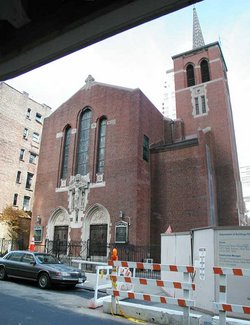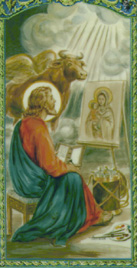St. Luke's Church (Dunell Hills)
| St. Luke's Church Ruined for some time, dark. AndyMatthews (talk) 17:22, 21 January 2025 (UTC)
|
| St. Luke's Church
Dunell Hills [0,32]
Basic Info:
|
There are three locations named St. Luke's Church in the city of Malton. This article is about the one in Dunell Hills.
St. Luke's Church [0, 32] is located in the northwestern section of Dunell Hills.
Description
Inside
You are inside St Luke's Church and The building has been very strongly barricaded ~ Braunwyn Cleanslate 11/11/07.
Outside
You are standing outside St Luke's Church, need in-game description.
Barricading Policy
The DHPD Barricading Policy provides that this building should not be barricaded, whether the suburb is in normal or Lock-Down condition.
Tactical Resource Points
The nearest of each type of tactical resource point to St. Luke's Church:
- Nearest Hospital is 2 blocks away - St. Justin's Hospital at [2, 31] or Catherine General Hospital at [2, 30].
- Nearest Mall is 19 blocks away - Caiger Mall at [19, 28].
- Nearest NecroTech Building is 5 blocks away - The Dury Building at [5, 36].
- Nearest Police Department is 1 block away - Cotty Street Police Department at [1, 33].
History and Significance
St. Luke the Apostle
Although there are no fewer than seven saints with the Christian name Luke, this church is undoubtedly named for Luke the Apostle, author of the third Gospel as well as the Acts of the Apostles. Alone among the writers of the Gospels, Luke was a Gentile (Colossians 4:14, in which St. Paul separates Luke from those "of the circumcision"); his writings are composed in the Greek tradition and emphasize different aspects of the life of Christ from the other Gospels, in order to better reach his Gentile audience.
There is evidence that Luke was both a physician and a slave; this is not contradictory, for in that time many households sent slaves to receive medical training in order to have an in-house doctor. He was probably born in Antioch, then the capital of Syria, and likely studied at Tarsus, where he may well have met St. Paul. Because his writings evidence a knowledge of the eastern Mediterranean, scholars have conjectured that he may have served as a shipboard physician before his conversion. He is a patron saint of physicians and surgeons, and many benevolent physicians' societies are named for Luke.
In the sixteenth chapter of Acts, the narration shifts from third- to first-person, indicating that Luke joined St. Paul at Troas on his second journey in about 51 CE, traveling with him through Macedonia. Luke was not imprisoned with St. Paul in Philippi, but spent the next seven years there encouraging the early Church. In about 58 CE, Luke again met with St. Paul on the third journey, eventually traveling with him to Jerusalem. Luke was with with Paul when he was arrested in Caesarea in about 59 CE and when he was finally brought to Rome in 61 CE (Philemon 24), and stayed by Paul's side during his final imprisonment there in 67 CE, long after Paul's other companions had left to continue their own ministries (2 Timothy 4:11: "Only Luke is with me.").
During Paul's final imprisonment, Luke had time to interview witnesses who had known Christ and to develop the knowledge of Jewish tradition evident in his writings. His Gospel was probably written soon after Paul's death, between 70 and 84 CE.
In his Gospel, Luke emphasizes Jesus' compassion for and patience with sinners and his love for all, whether Jew or Gentile. The well-known stories of the Good Samaritan, the sinful woman, the lost sheep and coin, the prodigal son, the good thief, and the one grateful leper appear only in Luke's Gospel. Luke shows a special connection with the women in Christ's life, especially Mary: the lines "Hail Mary full of grace" and "Blessed are you and blessed is the fruit of your womb Jesus" in the Hail Mary are taken from Luke's Gospel. Luke's Gospel recounts Christ's concern for the poor and for social justice. Luke also shows Christ at prayer before every important step of his ministry. Above all, Luke's Gospel emphasizes that anyone, rich or poor, man or woman, saint or sinner, Jew or Gentile, has the same opportunity to be welcomed into the Kingdom of Heaven.
There is little information about Luke's life after the death of Paul, and much of what exists is conflicting. Some early writers claim he was martyred; others say he was not. Some say he settled in Greece to write his Gospel, while others claim he traveled to Gaul to minister there. The earliest known account says he died in Greece in 84 CE.
Luke is frequently, and erroneously, depicted painting an icon of the Virgin Mary; in fact, Luke was not a painter, but so strong is the tradition that he remains a patron saint of artists and painters.

